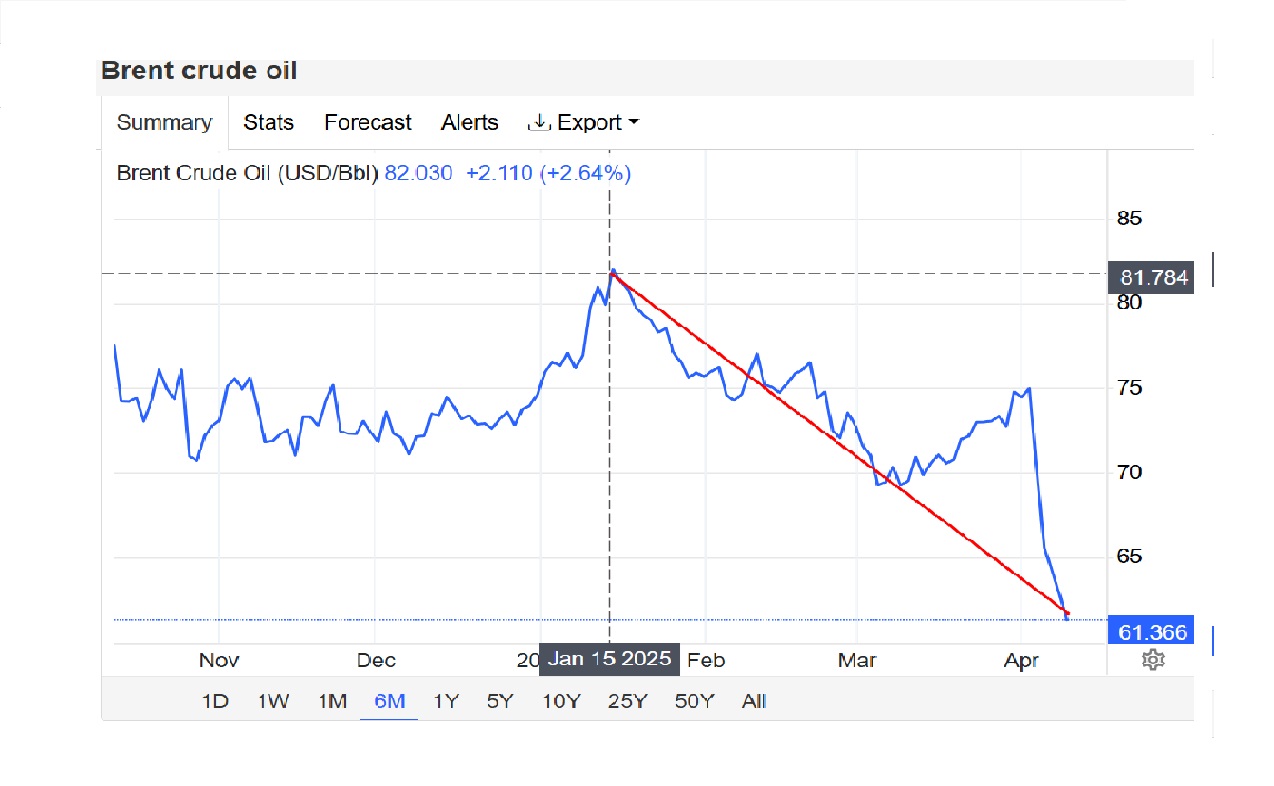
Цените на петрола достигнаха петгодишно дъно, но бензинът у нас не помръдва. КЗК (Комисията за защита на кражбите и корупцията) не вижда синхронното задържане на цените. Само от януари, когато Тръмп встъпи в длъжност, цените на петрола паднаха с над 33%, но по бензиностанциите някак си синхронно изобщо не помръдват — дори леко се покачиха. Приложение 1
За фиска това е прекрасно — повече данъци и такси. А бизнесът? Че става още по-неконкурентен — кого го е еня?
Вчера в Алмати заредих на цена от 60 ст. за литър, а във Венецуела преди няколко месеца беше — цели 1.7 ст. за литър.
При този намалял внос на енергоносители по обем (според НСИ), ако и цените им паднат с 33%, представяте ли си с колко ще се сринат приходите в измисления бюджет за 2025 година?
Вече писахме, че само за февруари дупката в бюджета гони 2 милиарда, при приходи от 3 милиарда.
 Дупката в Бюджета гони 2 милиарда само за месец
Дупката в Бюджета гони 2 милиарда само за месец
Така още дълго ще се „радваме“ на високи цени на бензина и дизела по бензиностанциите — иначе няма да има какво да се „усвоява“. Новите кредити които вземаме при 5% лихва, когато пенсиите ни се „олихвяват“ при минус 5% годишно.
Има още един важен момент — поради срутването на цените на петрола, цената на европейския Брент се изравни с тази на руския сорт Уралс. И двата се търгуват около 60 долара за барел. Така не е ясно, кой бе наказан с „митата“. Все пак САЩ не налагат мита на Русия, а на нас.
 Цената на петрола сорт Брент и Уралс се изравниха
Цената на петрола сорт Брент и Уралс се изравниха
Това означава проблеми за производителите в САЩ и Европа. За Русия не е сигурно, тъй като тя работи с дългосрочни договори със своите контрагенти.
Както знаете — колкото по-ниски са цените на енергоресурсите по света, толкова по-висока е цената на електричеството в България — за да има компенсация, разбира се.
Да не пророкуваме, но се очаква през юни цените на електроенергията отново да се повишат, тъй като енергоносителите драстично поевтиняват.
При газа всичко е ясно.
Днес тя струва 75.08 лв./MWh (без акциз и ДДС), докато…
 Цената на Булгаргаз днес
Цената на Булгаргаз днес
Какви са цените по референтните борси?
 Цената на референтната борса през 2021 и днес е същата
Цената на референтната борса през 2021 и днес е същата
През 2021 година, при същите референтни цени на международните борси, цената на природния газ в България е била 45.27 лв./MWh (без акциз и ДДС) — или просто почти два пъти по-ниска.
 Цената на природния газ през 2021 година на която е продавала Булгаргаз
Цената на природния газ през 2021 година на която е продавала Булгаргаз
Да обобщим: всичко над цената от 45.27 до 75.08 лв./MWh всъщност е комисионна. Защото купуваме същия този газ, който просто вече не се нарича „руски“… или нещо бъркаме?
Да не би всъщност да е същият газ, а ние просто да не знаем? Ама голямо незнание пада да знаете.
Все пак купуваме от Азербайджан или Турция, а те от …. Газпром, за което вече писахме.
Коментара е излишен и само от нас зависи!
Да са ни живи и здрави вредителите и комисионерите както и намалелите цени на електроенергията!
(1) ВРЕДИТЕЛСТВО (синоним на правителство, когато то не управлява, не прави и не допринася, а просто с всички сили вреди на нас, тези, които плащаме данъци)
(2) ЕК (European Commission или Европейско място за събиране на Комисионни според Oxford Dictionary – точно за този превод също писахме)
Ако искате да се заподнаете с повече детайли можете да посетите нашата страница, където няма цензура и манипулации, а и новините са в единната им цялост. https://bccci.net/bg/Новини/
Приложения
- Цени по международните борси Приложение 1
Like this:
Like Loading…
Нашия източник е Българо-Китайска Търговско-промишлена палaта
